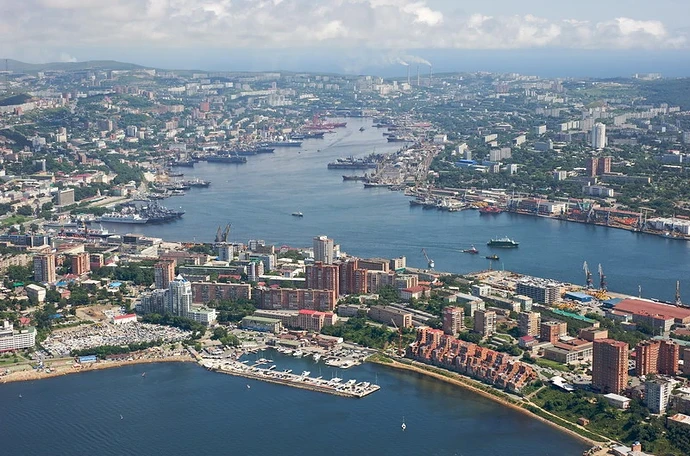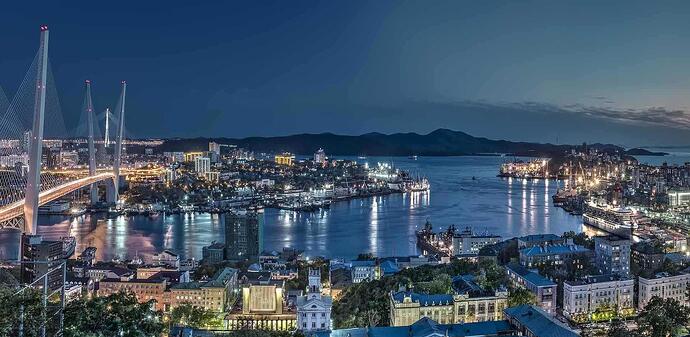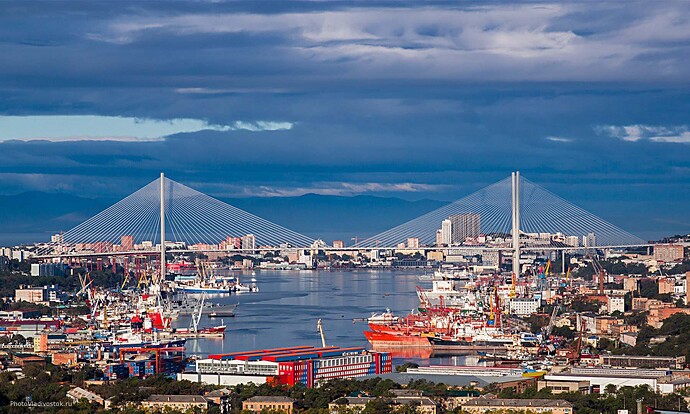Nestled on the rugged shores of the Sea of Japan, Vladivostok gleams like a rare gem in Russia’s sprawling Far East, a region otherwise marked by desolation and decay. Over 9300 kilometers from Moscow, separated by seven time zones and a chasm of economic disparity, this port city pulses with a vitality that feels almost otherworldly.
It’s a place where neon lights flicker against the backdrop of a vast empty land, where prosperity thrives in defiance of its surroundings. Beneath the surface of Vladivostok’s bustling streets lies a story of contradictions, a city flourishing through a brutal economic alchemy that siphons life from the region around it. This is the tale of Vladivostok’s warped prosperity, a phenomenon as mesmerizing as it is unsettling.
A City Apart: Vladivostok’s Contradictory Charm
Vladivostok is a paradox. Despite its modest size, home to just over 600000 people, it hums with an energy that belies its remote location. The city’s Golden Horn Bay glitters with modern infrastructure, from sleek bridges to bustling ports, while the streets teem with activity. Walk through its center, and you’ll find a curious blend of European architecture and Asian influences, a testament to its historical role as a crossroads of cultures. Beyond its borders, the Far East reveals a starkly different reality: decaying towns, abandoned factories, and a population dwindling faster than the region’s fading Soviet-era dreams.
The contrast is jarring, as if Vladivostok exists in a parallel universe, untouched by the malaise gripping the rest of Russia’s eastern frontier.Since 2017, Vladivostok has undergone a transformation, its skyline punctuated by new construction and its roads choked with traffic. The city’s economic ascent took a sharper turn in 2022, catalyzed by the Russia-Ukraine conflict.
While war often spells ruin, for Vladivostok, it has been a perverse kind of fuel, amplifying its growth while the surrounding region languishes. The city’s prosperity isn’t tethered to Moscow’s centralized economy, which feels like a distant overlord. Transportation across Russia’s vast expanse is arduous, rail journeys take days, and air travel is costly, rendering Vladivostok almost a separate economic entity, a beacon of vitality in a sea of stagnation.
Eastward Dreams: The Asian Connection
Vladivostok’s fortunes are inseparable from its proximity to East Asia. Just 45 kilometers from China and 134 kilometers from North Korea, the city is closer to Seoul and Tokyo than to Moscow. This geographical quirk has shaped its economic and cultural DNA. Wander through Vladivostok’s markets, and you’ll find Chinese produce dominating stalls, while restaurants serve Korean bibimbap alongside Russian borscht. The city’s car culture is perhaps the most striking symbol of this Asian influence: 80 percent of vehicles are right-hand-drive, smuggled from Japan where they’re cheaper than European imports.
This influx of Japanese cars, 250000 sold annually with 200000 shipped to other parts of Russia, has created a thriving industry of mechanics, importers, and dealers, employing one in three workers in Primorsky Krai.This Asian connection extends beyond goods to a mindset. Vladivostok’s entrepreneurs move with the decisiveness of their Korean and Japanese counterparts, a stark contrast to the bureaucratic inertia often associated with Moscow. The city hosts the Eastern Economic Forum, a platform where leaders from China, Japan, and India converge to forge trade deals and investment pacts.
In 2025, the forum drew 8500 guests from 75 countries, with China and India leading the charge. Agreements signed here focus on technology, infrastructure, and energy, signaling Vladivostok’s ambition to be a Pacific hub. The Chennai-Vladivostok maritime corridor has slashed shipping times between India and Russia’s Far East, boosting trade in oil, metals, and textiles. This eastward pivot isn’t just economic, it’s a cultural reorientation, as Vladivostok embraces an Asian dynamism that feels alien to the rest of Russia.
The Siphon Effect: A City Fed by a Region’s Ruin
At the heart of Vladivostok’s boom lies a phenomenon I’ll call the siphon effect, a relentless economic force that draws resources, people, and capital from the surrounding region into the city’s orbit. The Far East, spanning a third of Russia’s landmass but home to just 6.4 million people, is a resource-rich wilderness plagued by underdevelopment. Vladivostok, as the region’s unofficial capital, acts like a vortex, pulling in the ambitious, the desperate, and the opportunistic.
New residents, lured by the promise of opportunity, provide a steady stream of cheap labor that fuels the city’s service sector, restaurants, hotels, and retail thrive on their sweat.A darker current feeds this prosperity. The Russia-Ukraine conflict has poured unexpected wealth into Vladivostok through the families of fallen soldiers. The Russian government offers substantial compensation, up to 3 million rubles or 29000 dollars in some regions, for those killed in action.
In the Far East, where economic opportunities are scarce, these payouts are life-changing. Families, flush with cash, often relocate to Vladivostok, seeking a fresh start in a city that promises a better life. Their spending on homes, cars, and businesses further inflates the city’s economy, creating a feedback loop of growth. This wealth is built on loss, a grim reminder that Vladivostok’s shine is polished by the sacrifices of those sent to a distant war.
A Brutal Prosperity
Vladivostok’s story is one of brutal economic Darwinism. In a region where the economy is stagnant or shrinking, the city’s gain is the hinterland’s loss. The siphon effect concentrates wealth and opportunity, leaving the rest of the Far East to wither.
Towns beyond Vladivostok’s glow face population decline, down from 8.05 million in 1991 to 6.44 million today, and crumbling infrastructure. The city’s master plans, backed by 100 billion rubles in budget loans through 2030, promise new housing, museums, and energy projects, but these benefits are largely confined to Vladivostok and its satellite cities.
Rural areas languish, their resources and people drawn inexorably to the urban center.This isn’t just economics, it’s a microcosm of a larger truth. In a zero-sum game, prosperity for one often means poverty for another. Vladivostok’s rise, fueled by Asian trade, war-driven wealth, and the siphon effect, is a stark illustration of this principle. The city thrives not because of some altruistic vision but because it has mastered the art of capitalizing on its neighbors’ weaknesses.
It’s a prosperity that dazzles but leaves a bitter aftertaste, a reminder that in the Far East’s vast empty expanse, Vladivostok’s light casts long shadows.So, next time you hear of Vladivostok’s boom, don’t just marvel at its bridges or its bustling port. Look closer. Behind the gleam lies a city that thrives by draining the life around it, a place where prosperity is as beautiful as it is brutal.




